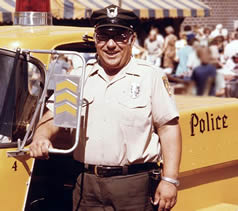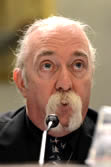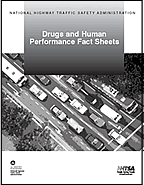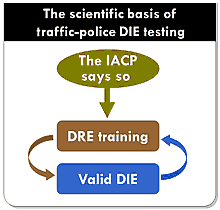 The
US law enforcement Drug Influence Evaluation,
a highly accurate scientific test that integrates
psychopharmacology
The
US law enforcement Drug Influence Evaluation,
a highly accurate scientific test that integrates
psychopharmacology
with neuro-ophthalmology,
and cardiovascular physiology,
and renal
xenobiotic biotransformation,
and
hepatocellular cytochome P450 enzyme dynamics,…
...was
made up by two policemen.
As the police DECP.org explains, a traffic-police Drug Influence Evaluation has lots of parts—measurements, "indicators", interpretations, a final opinion. Where do these parts come from?
1971
- 1984: No science
As recounted in NHTSA's DRE Training Manual, DIEs were made up in the early 1970s, by two Los Angeles policemen dissatisfied that juries were not convicting defendants the officers wanted convicted. The officers tried taking drivers to medical doctors, but doctors disagreed with their assessments and refused to diagnose impairment. So the two policemen "undertook independent research by consulting with physicians, enrolling in relevant courses, studying text books and technical articles, etc.," and began telling juries they had a scientific test for identifying drug impairment.
The scheme worked. Juries convicted.
"Proof of the effectiveness of the DEC program began to be accumulated from the very outset of the program. LAPD personnel demonstrated that they could conduct examinations that led directly to the conviction of drug impaired drivers and other drug law violators."
Drug Evaluation And Classification Training Program, The Drug Recognition Expert School, HS 172A R1/10, US DOT, NHTSA, January 2010; Chapter 3, page 4
 Read
that again. Notice that the program was effective
because it led directly
to convictions. According
to NHTSA, the purpose of the DIE is not accurate
scientific determination of impairment; the
purpose is convictions.
Read
that again. Notice that the program was effective
because it led directly
to convictions. According
to NHTSA, the purpose of the DIE is not accurate
scientific determination of impairment; the
purpose is convictions.
For more than a decade Los Angeles police got the convictions they wanted without bothering to do the scientific studies necessary to see whether their testing actually worked. The traffic-police DIE test had no basis in science.
In the
early 1980s the federal traffic safety agency,
NHTSA, learned of the LAPD program, saw that
it was good, and moved to take it nationwide.
But the "scientific" test NHTSA was
adopting had never been scientifically tested
—it had no basis in science.
Bigelow, Compton and Adler each use methodologies that render their conclusions about DIE accuracy scientifically wrong.
NHTSA paid for the science it wanted.- NHTSA paid for and self-published a lab project, Bigelow 1984 (aka Johns Hopkins).
- NHTSA had an employee write up an in-house field project, self-published as a NHTSA Technical Report, Compton 1985 (aka LAPD 173).
- Through the Arizona DOT, NHTSA funded a third project, reported in several stages, finally as Adler 1995 (aka the Arizona DRE Validation Study).
 These
three NHTSA studies each shared a failure that
is important for DIE practice and for DRE officers'
courtroom testimony. Each study failed to say
exactly how traffic-police DIE tests were done.
In the patois, they failed to reproducibly
describe how the DIE-like testing they studied
was done.
These
three NHTSA studies each shared a failure that
is important for DIE practice and for DRE officers'
courtroom testimony. Each study failed to say
exactly how traffic-police DIE tests were done.
In the patois, they failed to reproducibly
describe how the DIE-like testing they studied
was done.
Because
the studies failed to report what indicators
and interpretations officers relied on to form
their unstandardized opinions, NTHSA could not
identify which individual indicators and interpretations
made up the validated DIE. Turn that around
and no DRE officer could then, or can today,
correctly testify that any specific indicator
or interpretation his opinion relied on is scientifically
validated by any of these studies. Key
elements of the DIEs currently done by US law
enforcement have no basis is science.
2000 - now: Bureaucrats make it up

NHTSA called a meeting to make up the missing science.
In 2000 NHTSA, the National Safety Council, and the State of Washington Traffic Safety Commission put on the International Consultative Panel on Drugs and Driving Impairment. Delegates in "the fields of psychopharmacology, behavioral psychology, drug chemistry, forensic toxicology, medicine, and law enforcement experts trained in the recognition of drug effects on drivers in the field" guessed what DIE validation science would probably show. If there were any. Which there wasn't, or NHTSA wouldn't have needed the Consultative Panel.
 The
ICPDDI appears not to have published its minutes,
or proceedings, or any official report. It was
nonetheless used to justify NHTSA's Drugs
and Human Performance Fact Sheets, a compilation
purported to reflect committee guesses about
what validation science would probably show
are indicators of drug intoxication. If there
were any validation science. Which there isn't,
or NHTSA wouldn't have needed the Consultative
Panel. The guesses memorialized in the Fact
Sheets make their way to NHTSA's DIE Officer
training manual and from there into officer
testimony.
The
ICPDDI appears not to have published its minutes,
or proceedings, or any official report. It was
nonetheless used to justify NHTSA's Drugs
and Human Performance Fact Sheets, a compilation
purported to reflect committee guesses about
what validation science would probably show
are indicators of drug intoxication. If there
were any validation science. Which there isn't,
or NHTSA wouldn't have needed the Consultative
Panel. The guesses memorialized in the Fact
Sheets make their way to NHTSA's DIE Officer
training manual and from there into officer
testimony.
![]()
NHTSA's second strategic move was to redefine DIE evidence in a way that makes it in principal impossible for defendants to refute.
NHTSA brought in the International Association of Chiefs of Police to oversee and standardize the US law enforcement Drug Evaluation and Classification Program. The IACP publishes The International Standards Of the Drug Evaluation and Classification Program and revises and OKs the official NHTSA Drug Recognition Expert Training Manual. Notice that what the IACP standardizes is the DECP program—the DIE bureaucracy. The IACP does not standardize the DIE test itself. You'll see the importance of this in a second.
 Watch
carefully. As NHTSA hands DIE oversight to the
IACP, the agencies fix their DIEs-have-no-basis-in-science
problem. They switch the focus of the DIE—the
definition of what a DIE is—from
the DIE test to the DRE officers. Their claim
is not that the DIE test is accurate,
but that properly trained DRE officers are
accurate.
Watch
carefully. As NHTSA hands DIE oversight to the
IACP, the agencies fix their DIEs-have-no-basis-in-science
problem. They switch the focus of the DIE—the
definition of what a DIE is—from
the DIE test to the DRE officers. Their claim
is not that the DIE test is accurate,
but that properly trained DRE officers are
accurate.
 This
maneuver changes how DIE evidence works in court,
where the dispositive principal becomes not
science but officer training. To prove that
a defendant's DIE test was valid and reliable,
the prosecutor doesn't prove the test results
were interpreted according to validated scientific
standards, he just proves the DRE officer is
trained and certified.
This
maneuver changes how DIE evidence works in court,
where the dispositive principal becomes not
science but officer training. To prove that
a defendant's DIE test was valid and reliable,
the prosecutor doesn't prove the test results
were interpreted according to validated scientific
standards, he just proves the DRE officer is
trained and certified.
 DRE
officers are trained to do valid DIEs. A valid
DIE is whatever a trained officer does. Because
the IACP says so. A
defendant can never prove the DIE officer formed
his opinion in the wrong way, because the correct
way is defined as whatever a trained
DRE officer does. Identifiable science
is not part of the analysis because identifiable
science is not part of the definition.
DRE
officers are trained to do valid DIEs. A valid
DIE is whatever a trained officer does. Because
the IACP says so. A
defendant can never prove the DIE officer formed
his opinion in the wrong way, because the correct
way is defined as whatever a trained
DRE officer does. Identifiable science
is not part of the analysis because identifiable
science is not part of the definition.

